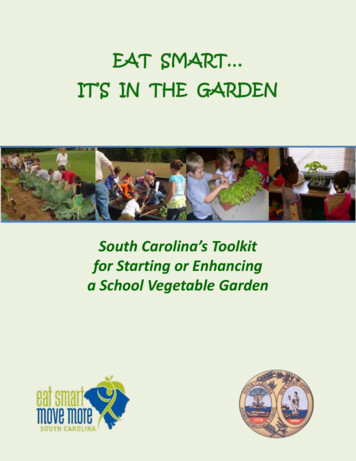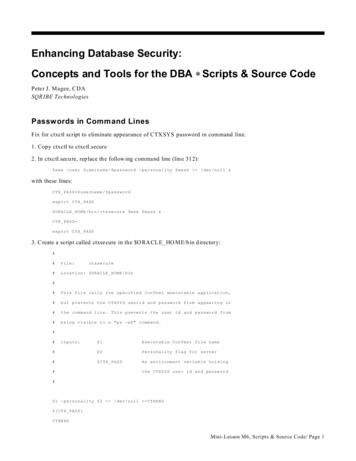
Transcription
EAT SMART IT’S IN THE GARDENSouth Carolina’s Toolkitfor Starting or Enhancinga School Vegetable Garden1
AcknowledgmentsEat Smart it’s in the Garden! South Carolina’s Guide to Starting or Enhancing a School Vegetable Garden is the result ofmany individuals and organizations that have devoted their time and effort to this endeavor. This toolkit could not havehappened without the hard work and commitment displayed by the following people and organizations:S.C. Department of AgricultureEat Smart, Move More SCDivision of Nutrition, Physical Activity, and Obesity2008-2009 Eat Smart it’s in the Garden Grant RecipientsBirchwood Middle School (Dept. of Juvenile Justice), Columbia - Debbie BlackmonCentral Child Care Development Center for Pre-K, Rock Hill - Dr. Linda HuchinsonMellichamp Elementary, Orangeburg - Amy CleggPauline-Glenn Springs Elementary, Pauline - Nancy Stewart, RNPontiac Elementary, Elgin - Wendy Myers2009-2010 Eat Smart it’s in the Garden Grant RecipientsFord Elementary, Laurens - Debra BishopGray Court-Owings Elementary, Gray Court - Kim RhinessHendersonville Elementary, Walterboro - Laura Lee RoseHolly Springs Elementary, Pickens - Pam JonesNevitt Forest Elementary, Anderson - Carolyn CromerOkatie Elementary, Beaufort - Helen GoodmanStone Academy, Greenville - Nancy DavisSummit Drive Elementary, Greenville - Allison WalkerYork Technical College Child Development Center, Rock Hill - John HayesMary Kay Face, Administrative Assistant to the Division of Nutrition, Physical Activity, and Obesity; S.C. Department ofHealth and Environmental ControlMarie Lybrand, Administrative Assistant to the Commissioner, S.C. Department of AgricultureThe School Garden Advisory Committee.We also thank the Greater Greenville Master Gardeners’ for permission to use the 2009-2010 Clemson Master Gardeners’School Gardens Handbook in the development of the Eat Smart it’s in the Garden toolkit. Additional thanks go to theCalifornia School Garden Network’s Gardens for Learning, which was also adapted and used with permission in thedevelopment of this toolkit.This publication was developed through a joint effort of the SC Department of Agriculture; Eat Smart, MoveMore SC; and the Division of Nutrition, Physical Activity, and Obesity at SC DHEC.This publication was supported in part by Cooperative Agreement Number DP08-805 from the Centers forDisease Control and Prevention. Its contents are solely the responsibility of the authors and do notnecessarily represent the official views of the Centers for Disease Control and Prevention.i
Table of ContentsAcknowledgments iLetter from the SC Commissioner of Agriculture .iiEat Smart .it’s in the Garden Program 1What is an Eat Smart it’s in the Garden Program?. 2Why Garden at School?.3Planning Your Garden .4The Roots of Your Garden – Establishing a School Garden Committee .6What Type of Garden is Right for Your School?.9Choosing the Type of Garden You Want to Grow .11When, What and How to Plant 14Harvesting Resources – How to Leverage Local Resources .17Choosing a Garden Theme .19Tool Storage and Garden Security .20Water – Keeping Your Garden Hydrated 21Composting - Recycling Makes a Better Garden . 22Maintenance- Keep it Growing 23Student Involvement – Academic and Physical 24Community Involvement 28Harvesting – Reaping What you Sow .29How to Make the Most of Your Fresh Produce from the Garden . 30Using School Garden Produce Safely .31In for the Long Haul - How to Sustain Your Garden .32Monitoring Your Garden Progress 34Harvesting Success – Fellow Teachers Share Their Stories .36State School Garden Coordinator – A Key to SC’s Success 43
AppendicesAppendix A – SC Overweight & Obesity Fact Sheet – Children 44Appendix B – Resources 46Appendix C – State & Local Contacts .47Appendix D – Clemson Extension HGIC – Planning a Garden .48Appendix E – Pollination & Bugs – Balance the Good and the Bad .52Appendix F – Grant Opportunities .57Appendix G – Sample Donation Request Letters 58Appendix H – Home Grown Lesson Plans 60Appendix I – Sample Media Advisory and Sample News Release 67Appendix J – 2009 SC School Garden Survey Results .69Appendix K – School Garden Checklist & Timeline .73
Eat Smart it’s in the Garden ProgramThe Eat Smart.it’s in the Garden program began as a collaborative effortbetween the SC Department of Agriculture and Eat Smart, Move More.SC(ESMMSC).The program provides a connection between agriculture,education, and a healthy lifestyle.It also helps the state in addressingIf the current obesitytrends continue amongchildren, 30% of boysand 40% of girls bornchildhood obesity.in the year 2000 willIn 2008, an initial survey was distributed to contacts throughout the state todevelop Type IIobtain general information about schools with gardens and those interesteddiabetes, primarily duein starting a garden. Results indicated interest from many schools on how toto a poor diet and lackestablish a garden or how to expand or revitalize an existing garden.of physical activityThrough funding support of ESMMSC, five sites were awarded grants in(see Appendix A: SC2008-2009 for establishing or expanding gardens in their schools. Due toObesity Fact Sheet –the success of these initial Eat Smart.it’s in the Garden sites, nineChildren)additional schools were awarded grants in 2009-2010 as shown in the mapbelow.This toolkit was developed based on the lessons learned from the Eat Smart it’s in the Gardengrantees. It was designed to serve as a guide to help SC teachers and other school staff create,maintain, and sustain vegetable and fruit gardens in their own schools. Not every school gardenin SC has to become an Eat Smart it’s in the Garden site. For a more successful, long-termsustainable effort, consider this model as you start the process of implementing a garden at yourschool.Eat Smart.it’s in theGarden Grant Recipients2008 – 20101
What is an Eat Smart.it’s in the Garden Program?Eat Smart it’s in the Garden provides a model, comprehensive approach toimplementing a school garden program. The program is comprised of “9 essentialelements”:School garden committeeVegetable and/or fruit gardenLeveraging resourcesStudent involvementCurriculum integrationCommunity involvementUse of produce in school/communityStone AcademySustainabilityMonitoringNevitt Forest Elementary2
Why Garden at School?A School Garden is YOUR Toolkit for LearningThe Garden is an effective tool for promoting student learning,enhancing instruction, and increasing community involvement.The way you use the school garden will be determined by theunique needs and interests of your school community.School Gardens can:Enhance the instruction of many SC educational standardsfor pre-K through grade 12York Technical College ChildDevelopment CenterSpice up normal classroom activities and lessonsTurn the classroom into a sensory learning lab. Taste, see,smell, hear and touch food and how it affects us allExpose students to healthy lifestyle choicesInvolve students with diverse needs and talentsEncourage healthy eating and activity habitsCultivate environmental awareness and stewardshipAccording to oneteacher, “thestudents arebecoming aware ofthe nutritionalExpose children to new food experiencesbenefits of freshEnhance mental and physical functionproduce and arePromote student bonding and teamworkmore willing to tryIncrease parental interaction and involvementEncourage community participationProvide an outlet for student stressnew food items.They are wanting toeat healthy.”Increase brief exposure to sunlight to help with Vitamin DproductionOffer fundraising opportunities for schools3
Planning Your GardenThe thought of having a school garden is very exciting and you may want to just “digright in!” However, before you start the actual gardening process, there are severalthings to consider. This toolkit can help you answer these questions.Why?Why start a garden?Why have a garden on school grounds?Who?Who will be our leadership support?One school nursedescribes the principalWho will be involved in the garden?Who will be in charge of gardening activities?as being “veryinvolved” in the schoolgarden. “[TheWhat?principal] has helpedWhat are the purpose and goals of our school garden?the children plant theirWhat is the plan to reach these goals?vegetables. She postedWhat support do we currently have?information regardingthe garden in ourWhat kind of garden do we want to create?school news program,What types of plants will be grown?our parents’ newsletter,What subjects do we want to teach with the garden?and in our schooldistrict. She alsoWhat will we do to link these lessons to educationalstandards?helped with theordering of supplies.”What local resources can we utilize?What local businesses will we contact for help with resourcesand tools needed for the garden?4
When?When should we plant a garden?Where?Where should we plant the here are our water resources located?How?How will we obtain the resources needed to start a garden?How will we leverage local resources and funding for agarden?How will we maintain the garden during the school year andduring the summer?How will we continue to sustain the garden after it iscreated?Gardening ResourcesGrowing A Healthier otherresources to help with the gardeningprocess are found in Appendix B.5
The Roots of Your GardenEstablishing a school garden committeeHaving a team that supports the idea for a school garden is important for the garden’ssuccess. You will need a team that can work together to plan for, create, maintain, andsustain your garden. It is helpful if the committee consists of key members that who willactively participate in the creation and upkeep of your school garden.The gardencommittee can be used to discuss what types of vegetables to plant, the location of thegarden, the type of garden that will be planted, how to gain useful and affordable resources,and establish times to work in the garden. Within the garden committee, it is also helpful tofind a dedicated and organized Garden Coordinator. This individual can also be in charge ofcommunicating, scheduling, and organizing committee meetings and garden plans. It mayalso help for this person to have some gardening experience.Individuals whom you may want to include in your school garden committee or obtainsupport from are listed below: Principal/Vice-Principal Teachers School Nurse Food Service StaffDon’t forget to checkwith your SchoolImprovement Council(SIC) or School HealthAdvisory Council(SHAC) when you are inthe process of planningyour school gardencommittee! Librarian Maintenance Staff Parents/PTO Students Community VolunteersYour school mayalready have an activeschool improvementteam or other existingcommittee that wouldbe willing to take on theschool garden programas a priority.6
Principal/Vice-PrincipalThe principal is a key member who can ultimately give you approvalfor the garden to be created. The principal can allot time for rawincommunity/parental support, be involved with the planning processand recruitment of school garden committee members, and fulfillOne teacher states,other leadership responsibilities.“We havePrincipals may also be able toprovide year round oversight of the garden project.tremendous supportfrom [otherTeachersTeachers can be involved in a number of activities including:incorporating the school garden into their lessons/curriculum,coordinating activities, planting crops, seeking resources, recruitingvolunteers, and spreading information about garden activities to thecommunity and school.School Nurseteachers] as well asfrom our assistantprincipal. [she]attends each of ourplanning meetingsand is excited aboutthe amount ofHaving the school nurse involved with the garden will help connectteaching andthe school garden to the health and well being of your students. Inlearning that isaddition, school nurses can assist with finding curriculum connectionstaking placewith health, safety, nutrition, and hygiene in the garden. The nurseoutside, usingcan also be available in case of potential bug bites or scratches.hands-on methods.”Food Service StaffHaving food service staff on board with the garden will help to makethe best use of your produce by providing resources for preparingtaste tests in the classroom or by incorporating produce in thecafeteria. In addition, these members can provide leftovers from thecafeteria for composting. School food service staff can also provideguidance on food storage and safe handling practices.7
Librarian and Media SpecialistsSchool librarians and media specialists can be helpful by finding resources related to schoolgardening for the students, which can cultivate further interest and excitement in the garden.They can also find related literature for the teachers and parents.Maintenance StaffMaintenance of the garden proves to be a challenging task for many teachers and gardenmembers, so including maintenance staff in your school garden committee may be helpful for asuccessful garden. Maintenance staff can help maintain the garden during the academic breaks,and assist with storage, tools, and irrigation.Additionally, maintenance staff can provideinformation about chemicals used on school grounds near your garden for the safety of thoseindividuals participating in the garden or eating produce from the garden.Parents/PTOIt is helpful to have parents involved in the school garden committee because they can provideresources, supplies, funds, and volunteer to assist in the coordination and maintenance of thegarden. Some parents may even have gardening experience that can be helpful in planting,harvesting crops, and upkeep.StudentsTo gain the most benefit from school gardening, students should be involved in all stages of theprocess. By including students in the school garden from the beginning, they gain ownership ofthe garden.Community VolunteersVolunteers from the community can identify and leverage community resources, act as a liaisonfor local community events and government, provide assistance with garden maintenance duringthe summer and school year, and provide gardening knowledge, supplies, and other resources.Gray Court-OwingsElementary8
What Type of Garden is Right For Your School?There are many types of gardens and garden themes that can be designed at schools, but the gardenyou choose will depend on your school’s goals and purpose for the garden and the resources youhave available. After reviewing your goals, choose a type of garden that fits your needs. Then,depending on what will be grown in your garden, choose a location that will best suit your producedepending on sunlight, soil, and water. Below is a quick reference chart to help you determine whattype of garden is right for your school.Container GardenRaised Bed GardenIn-Ground GardenUse pre-mixUse pre-mixNeed full sun (6-8hours)Locate where you have Locate where plot willfull sun (6-8 hours)receive full sun (6-8 hours)Hose, drip irrigation, or Hose, drip irrigation, orsprinklersprinklerWaterNeed a readilyaccessible watersource (i.e.watering can orhose)Usually not a problemDrainageMake sure to haveholes in the bottomand a layer ofgravelSoilSunNeed to test before plantingAvoid low lying areas wherewater stands for more than afew hours after hard rainDetermine the right size for your gardenMake sure to choose a location with enough room for your gardenConsider the age and size of the children who will be working in the gardenA 12- by 16-foot plot is usually large enough to grow a variety of greens, some herbs, a few tomatoesand peppers, beans, cucumbers and even edible flowers such as nasturtiums for garnishesIf you do not have that much available space on your school grounds, a smaller outdoor garden can stillgrow some fruits and vegetables, or you can choose to house container gardens inside the classroom9
Be close to a water sourceIn most places, rain alone is not sufficient to hydrate fruits and vegetables, so itimportant to be close to a water source such as a hose bib or water spigot.Check the soilIf growing a garden in an area of soil on your school campus, make sure to havethe soil checked. Your local Clemson Extension can test your soil for you (seeAppendix C). Compost and fertilizers will also help to add nutrients to your soil. Ifyou don’t have a large spot of soil on your campus, you can build a garden onasphalt by using raised beds.Choose a sunny spotMost vegetables need 6-8 hours of direct sunlight every day. Leafy greens suchas lettuce or cabbage can handle less sunlight, but fruiting vegetables such astomatoes need at least 8 hours of light every day. In general, you should choosea location for your garden that is to the south or west of a building in order to allowfor the greatest amount of sunlight for your crops.Ford ElementaryGreenville Children’s Garden10
Choosing the Type of Garden You Want to GrowDifferent types of gardens include container, raised bed, and in-ground plots, just to name afew. The garden you choose will depend on the resources that you have. If you don’t haveadequate space on school grounds to create a larger garden, you may want to stick with anindoor container garden. If your school has an open area with an accessible water source, anin-ground plot or raised bed garden may be more suitable for your vegetable garden.Just Getting Started?Growing herbs in a container can be a greatway to get started and they are easy toincorporate later in larger raised bed or inground gardens.York Technical College ChildDevelopment CenterSeed Starter Trays: To plant a seed starter tray you will need peat pods for each studentin the class and a greenhouse dome to cover the tray. Peat pods should be soaked inwater for about 30 minutes before students can press their seeds into the peat pods. Thecontainer garden needs to be placed near a window where it will get plenty of sunlight.Once the plants grow tall enough (about 2 inches), you can remove the clear dome.11
Is a Container Garden the right fit?Container gardens can be indoor or outdoor. You can growyour vegetables near windows or bright sunny areas. TerraSoil Testingcotta pots or plastic containers are readily available at mosthome and garden stores and are perfect for growing certain* You can test yourvegetables such as tomatoes and peppers.soil’s pH as a classroomactivity using litmusIs an Outdoor In-Ground Plot the right fit?paper, or you canTo have an in-ground garden plot, find an open space on yourcontact your localschool grounds. This area needs to be a sunny spot in whichClemson Extension torain water does not often settle. Mark off the garden area andtest your soil for you.clear all grass, weeds, and debris. It is important to get your Most vegetables need asoil tested in order to have a proper pH level. After taking soilsamples, till the area to prepare it for planting. Based on yoursoil pH level between 6.0and 6.8.soil analysis, you may need to incorporate nutrients by addingcompost or fertilizers during or immediately after tilling. To dothis, spread compost, moss, or organic matter over the soiland rake it into the top few inches of the soil. Having thecorrect soil pH will maximize your garden yield.Okatie ElementaryNevitt Forest Elementary12
Is a raised bed garden the right fit?Raised bed gardens can be helpful in organizing your garden in neat rows, and can also bebeneficial if you have poor soil quality or drainage issues. For a raised bed garden, find asunny location on your school campus that is close to a water source. To house your raisedbed garden, you can create a square or rectangle with naturally rot-resistant cedar or othertype of untreated lumber. Add nutrient rich soil to the top of the bed and then add about 1inch of mulch (mulch helps to retain moisture around the plants). Finally, rake the top of thebed to smooth it.Gray Court-OwingsElementaryIs a greenhouse the right fit?No matter what size the school greenhouse, students can learn about plants, investigaterelationships between plants and insects, and experiment with water movement, pollination, andnutrition.How you plan to use your greenhouse will influence the type of greenhouse youbuild/buy. A greenhouse provides a controlled environment for growing a variety of plants. It isimportant to pick a location for your greenhouse that will give you adequate sunlight. Otherfactors to consider include shade, access to water, ease of access for students, andpotting/planting areas.Determining when and what to grow will be based on your students’interest and your curriculum plans.13
When, What and How to PlantWhen to plantSouth Carolina has a climate capable ofgrowing many different types of fruits andvegetables year round.Planting times varydepending on the region of South Carolinawhere you live. For example, if you live in theFord ElementaryUpstate, it may be beneficial to plant warmseason vegetables later in the spring and coolseason vegetables earlier in the fall, comparedto recommended planting times for the Centraland Coastal regions of the state.What is fun and easy togrow? Radishes Lettuce Beets Broccoli Beans Spinach Edible FlowersYork Technical College Child Development Center14
What to PlantSeeds can be started indoors between January and February and will need to be transplanted to yourgarden at a later time. Some vegetables, however, can be planted straight from the seed such as beans,beets, cantaloupe, carrots, corn, cucumbers, lettuce, okra, peas, pumpkins, and spinach. If you chooseto grow vegetables that you will be able to harvest in a short amount of time, lettuce can be grown in 25days and radishes can be grown in 45 days. Beets, broccoli, beans, or spinach will mature in 50 days.Additional vegetables and their corresponding planting ranges are listed in the following tables:Warm Season Vegetables – Plant these in the spring to harvest before school is out for summerPlant varietiesWhen to plantDays to maturity from seedCantaloupeLate March –Early May30-35CucumbersLate March – Early May50-70EggplantApril – May65-80Southern PeasApril – May65-125April – Mid-May60-70April – May70-85March – April80-95April – Mid-May55April – May55-105Late March – April55OkraPeppersSweet CornSquashTomatoesBeansCool Season Vegetables – Plant these vegetables in the fall to harvest before winter breakPlant varietiesWhen to plantCabbageEarly AugustCarrotsEarly AugustCollardsAugustLettuceLate AugustDays to maturity from seed60-8065-757055-75RadishesSeptember - November21-28SpinachLate Sept – Early Nov37-45BeetsBroccoliCauliflowerTurnipsEarly AugustAugust - Early SeptemberEarly AugustSeptember – Early October50-7065-7060-7050-6015
How to PlantOnce your garden area is ready, it is time to start planting seeds! Seeds should be planted inthe ground at the depth that is about two times their diameter. If you began the seedsindoors and are transplanting them, make sure to place the transplants into the ground at thesame level that they were growing in the containers inside. Also, it is not good to plant toodeep because the roots will not be able to get enough air. If you are unsure how deep toplant seeds, check the seed packages for proper information. Once the seeds are planted,make sure to water the plants right away. For more information, see Appendix D.As you progress with your garden, consider adding permanentvarieties such as fig trees, blueberry bushes, and dwarf pear trees.Helpful Hint:If you want to cut downon harvest time, visityour local nursery toget seedlings.Nevitt ForestElementaryAttracting insects toyour garden will helppollinate your plants.For more informationabout pollination, seeAppendix E.16
Harvesting ResourcesHow to leverage local resourcesIn order to initially create your garden and to keep your gardenFor more information aboutthriving, you may need numerous resources. Using internal andexternal resources is helpful in having a successful garden.leveraging local resources, youcan contact a local SC NurseryExternal resources can be attained through numerous methods,and Landscape Associationbut grants appear to be a popular method for many SC schoolmember near you. SeevegetableAppendix ls, school funds, and fundraisers are additional resourcesthat can be used for your garden.GrantsGrants are very helpful resources for schools to manage their gardens. Grant money can comefrom local, state, and federal government, private foundations, corporations, and otherorganizations. In order to receive grant money, your school will submit an application, whichshould be thoroughly developed and reviewed.Make sure to follow the instructions for theparticular grant you are applying for and provide a persuasive argument for why you shouldreceive money for your school garden.A list of possible grant opportunities is provided inAppendix F.One teacher in the Upstate says “The community garden store has analyzed thegarden soil and sent recommendations. They have also provided some free fertilizers.Several parents have bought and donated garden gloves for the children. Acommunity member bought and donated recycled buckets for the grade levels to storetheir garden supplies. Parents provided the wood used in our garden markers andalso donated all the seeds and some plants.”17
DonationsDonations are another valuable resource for school gardens.Often parents, communityvolunteers, other teachers, and local businesses are willing to supply donations for schoolprograms.When asking for donations, target businesses with services that match yourneeds and be specific and professional in your requests. Remember that donations do notjust include money, but also can be in the form of supplies such as seeds, tools, and lumber.Sample letters are available in Appendix G to help you ask local businesses for donations.Remember when receiving donations, make sure to always acknowledge and thank yourdonors.FundraisingFundraising can be a successful tool for gaining community involvement and resources foryour school garden. It can also provide a positive learning experience for students. Forexample, harvested produce or small bunches of flowers from the garden could be sold to thelocal community. Other items that are created from the garden such as potpourri or papermade from pressed flowers could be sold or auctioned at a school event.South Carolina School Garden Blog:This site ismaintained by the S.C. Department of Agriculture for thepurposes of sharing information and funding opportunitiesthat may be of interest to school gardens. For example,the Bonnie Cabbage Plant program is an annual programthat Bonnie Plant sponsors giving students cabbage plantsto grow and compete for prize money based on the largestcabbage plant grown in every state. For more information,see Appendix B.Ford Elementary18
Choosing a Garden ThemeSometimes having a garden theme is a creative way to make gardening a little more fun andexciting. The following themed gardens produce fruits, vegetables, and other tasty edibles:Theme GardensPizza garden or Salsa Garden: Grow toppings for pizza or make your own salsa withtomatoes, onions, and peppersLiterature Garden: Grow plants from popular childrens’ booksHerb Garden: Herbs can be grown in containers or in the ground with other plantsNative American: Learn about our Native American culture by growing native crops such asmaize, squash, and beansMulticultural Garden: Learn about different cultures by growing plants from around theglobe such as soybeans, yams, ginger, jicama, cassava, and Chinese cabbageNutrition Garden: Learn about nutrition while growing a combination of healthy vegetablesNative Plants: Grow plants that are native to the area of your school’s locationHistoric or Heirloom Garden: Grow plants mentioned in history such as dill, mint, andbarley. You can also find and grow historic heirloom varieties of plants such as yellowtomatoes, purple peppers and white eggplantArtwork decoratingthe BlueberryGarden at StoneAcademy19
Tool Storage & Garden SecurityIt is important to give some thought to how you will store your garden tools and stepsyou may need to take to secure your garden. Proper storage of tools can save you time,money, and help avoid potential injuries. Storage and security options include:Shipping container – highly secure structure for storage of toolsPlastic waste bin for upright storage of long handled toolsStorage shedAirtight and waterproof containersWagon for hauling tools to garden siteHolly SpringsElementarySticky Fingers in GardensAs your garden grows in popularity and as produce becomes ripe for harvest, there’s achance that it could disappear.Consider if your garden will need additional securitymeasures to preserve your produce for harvest.20
Water – Keeping Your Garden HydratedIrrigationSince rain is often not enough water for plants to grow., it is important to sufficiently water yourplants. If you have raised beds, you will need to water the plants more frequently because the soildrains well. A rule of thumb is, if you stick your finger about 1 inch in the soil and it is dry, then youneed to water your plants. Make sure to a
The Garden is an effective tool for promoting student learning, enhancing instruction, and increasing community involvement. The way you use the school garden will be determined by the unique needs and interests of your school community. School Gardens can: .










